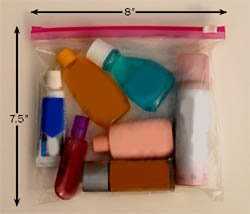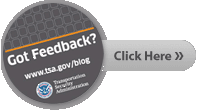The Path Forward on Liquids
 When it comes to liquids, everybody involved with checkpoint operations -- passengers, airlines, airports, and TSA employees -- agrees that there has to be a better way. Here’s my take on the path forward.
When it comes to liquids, everybody involved with checkpoint operations -- passengers, airlines, airports, and TSA employees -- agrees that there has to be a better way. Here’s my take on the path forward.For this discussion, I am using “liquids” as short-hand for liquids, aerosols, and gels and other novel types of explosives.
Intelligence shows that terrorists innovate in explosives formulas as well as the way they would bring them onboard an aircraft. That won’t change any time soon. If liquid restrictions are eased eventually it will be because of improved process and technology, not diminished threat.
Technology
TSA uses several technologies that are effective against liquid and other novel explosives.
Standard X-Ray is deployed everywhere and can effectively identify the presence of liquids and their containers. It is not reliable in differentiating all threat liquids from non-threat liquids. It is effective in the 3-1-1 environment by identifying whether there are liquids hidden in a bag – thus it is useful as a compliance tool.
Advanced Technology “AT” X-Ray is the next generation of X-ray equipment that has technology to examine the dimensions and density of objects within a carry-on bag. 500-600 (out of a total of about 2,000 lanes) will be deployed by the end of 2008. TSA will come close to doubling that number in 2009. AT X-Ray has two major advantages over standard X-Ray:
1) Better image resolution from the hardware side – it uses multiple view points; and
2) Smarter software. The image resolution benefit is immediate; the software will be improved over time.
More than 6,500 Trace Detection “ETD” units are deployed at both checkpoints and checked baggage areas to detect minute particles of explosives residue through the collection of trace samples. TSA has several hundred handheld ETD’s that are capable of detecting explosives particles as well as vapor.
Computed Tomography (CT) Scanners are checkpoint-sized versions of the large checked baggage scanners that have MRI-like capability that will detect anything – solids and liquids. They are large and expensive so TSA does not have many of them. We will be deploying them in smaller airports to screen both carry-on and checked baggage.
Several hundred bottle scanners - handheld or bench-top devices –are deployed throughout the country to provide TSA with the capability to differentiate liquid explosives from common, benign liquids. We use them to test exception liquids (medical needs above 3.4 ounces) and for spot checking passengers and bags.
Spectrometers, very advanced handheld units that can resolve any threat regardless of the chemistry involved, have been issued to TSA Bomb Appraisal Officers at major airports.
Hundreds of dropper-based or test strip-based chemical analyzers kits are deployed at smaller airports to resolve any concerns about individual exempt liquids larger than 3-1-1 in carry-ons.
About 40 Whole Body Imagers are deployed to larger airports around the country to date, and about 80 more will be deployed by spring-time. These are the walk-in portals that scan the body and can detect concealed items, including liquids.
And while they’re not actually a technology, it is important to note that about 2,000 TSA officers have been specially trained in Behavior Detection.
In addition, every officer in the country is receiving two days of specialized training – going on right now – to get at evolving threats, including liquids. To keep current, TSA runs IED drills every shift across the country, every day.
K-9 Teams (over 500) are another effective explosives detection capability and we use them in passenger areas, around the airport, and have several hundred additional teams just for air cargo.
Path Forward
We are deploying the best technology and training as fast as we can get it. The goal is to remove all the restrictions on liquids when we have automated systems that can accurately separate threat from non-threat liquids. Here’s the plan:
Now: We are pretty close to having a network of AT-X-Ray deployed so that nearly 70% of daily passengers will be using major airports with AT. TSA is getting the hardware installed so that when the software is ready in the next year or so, all we have to do is a software upgrade. We will be testing software versions in the coming months.
Fall-2009: Size restriction removed, but all liquids will have to be placed in a separate bin. AT X-Ray software will be advanced enough to tell the difference between threat and non-threat but not yet proven to tell the difference when it is hidden in a bag.
End of 2010: No restrictions. AT X-Ray will have upgraded software that is proven to detect threat liquids in any configuration and is deployed in enough places so that TSA can change the rules to meet one uniform standard for the country.
Next Steps
TSA is working with our partners around the world to share technology both ways and this has resulted in a faster development process and will mean that there could be common design standards with major partners like Canada, the EU, and Australia.
It is also likely that when the U.S. takes steps on liquid restrictions, we will do so in harmony with others, as we did with the 3-1-1 (three ounce container/one quart bag/one bag per person) liquids rule. It is fair to say that we and our global partners see the threat in the same way and know that a common, high level of security encompassing a large part of the world is in everybody’s best interests.
Right now at home, we’re looking at some short term options based on passenger feedback and input from airports and airlines. We think there is an opportunity to build on the Diamond Self-Select lanes systems that we have tried in 2008.
The Diamond Self-Select lanes system, where expert travelers and families choose the lane best suited for them, has worked well. The expert lanes are fast and the Family lanes are hassle-free and they are at 45 airports today. TSA, airports, and airlines can further develop that concept, and we’re looking at something along the following lines.
- Limit the Black Diamond (Expert) lanes more formally beyond self-select.
- By number or size of carry-ons?
- By 3-1-1 only, no exception liquids?
- Focus liquid detection technology at the Family/Special Needs lanes and ask those with exception liquids to go there – speeding up the other lanes in the process?
Liquids restrictions are with us for the better part of the next year but we all realize that a simple, hassle-free security process is good for passengers and security too. Thank you for coming to TSA.gov and I am looking forward to your feedback.
Kip Hawley
***Update 10/27/08***
3 oz or 3.4 oz? What gives???
OK, here’s the scoop. If the U.S. would have switched to the metrics system in the 70s, this wouldn’t be an issue.
When the TSA lifted the total liquid ban and implemented the 3-1-1 program, the permissible amount of liquids, aerosols and gels was 3oz. Press releases went out, WebPages were updated, and signs were printed and shipped out nationwide to 457 airports. A lot of work went into the 3-1-1 campaign.
When the TSA rolled this out, the European Union was not on board yet. When the EU decided to allow liquids to travel, the amount permitted was 100ml. Well, as we all know, 100ml = 3.4oz. not 3 oz.
In order to align with the EU, we decided to allow liquids in containers up to 3.4oz, but we decided to keep our signage the same. The 3-1-1 program was so successful, that it would have been a shame to change it to 3.4-1-1. J
TSOs nationwide should be allowing liquids up to 3.4oz. If they are not, you can ask for a supervisor or you can use our Got Feedback program.
Bob
EoS Blog Team






